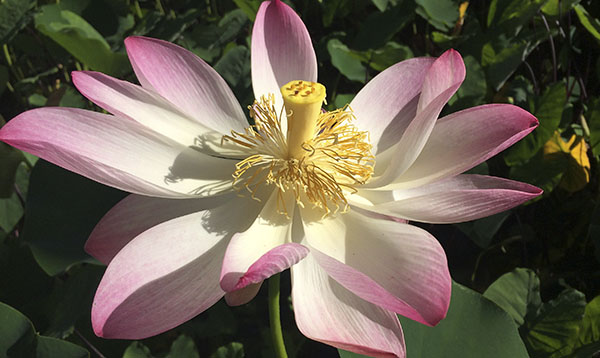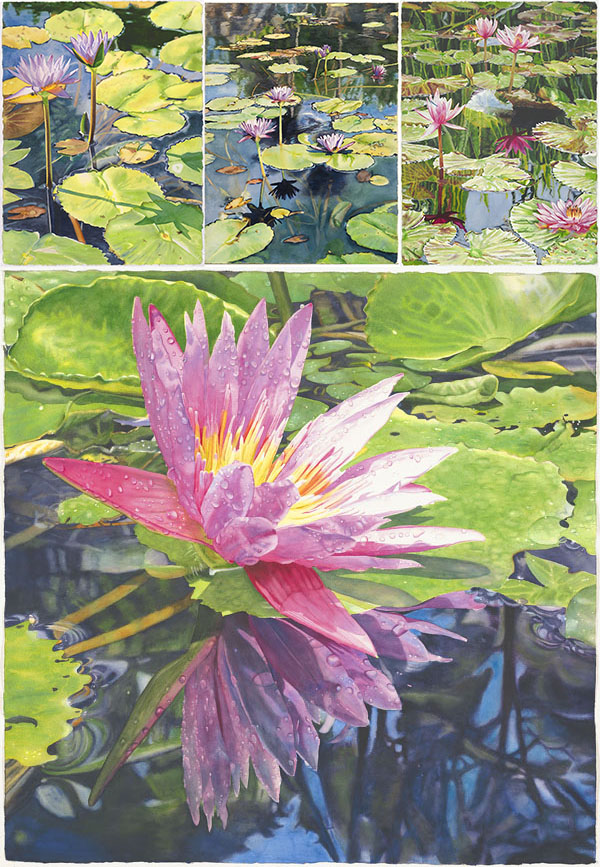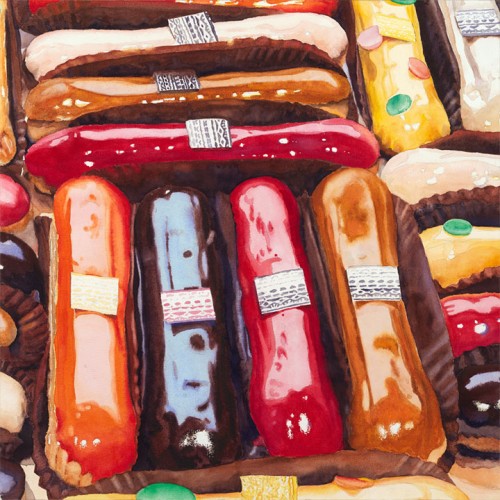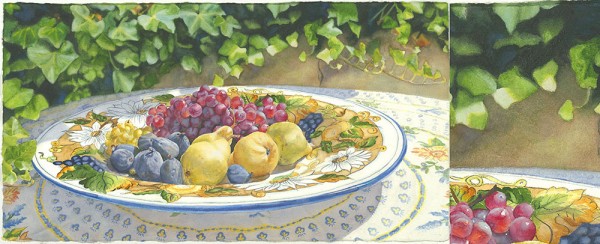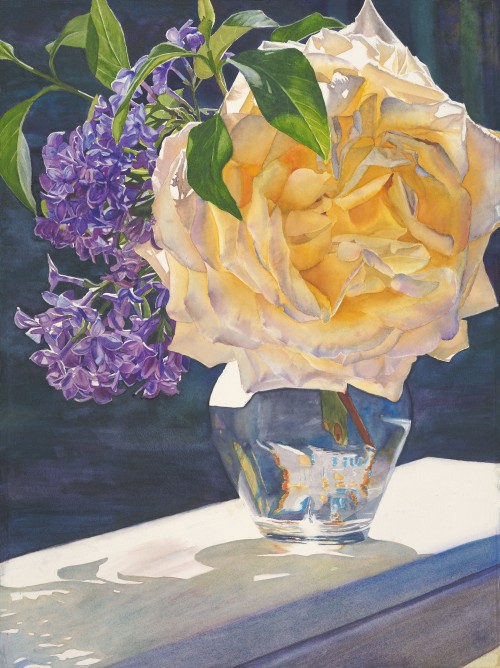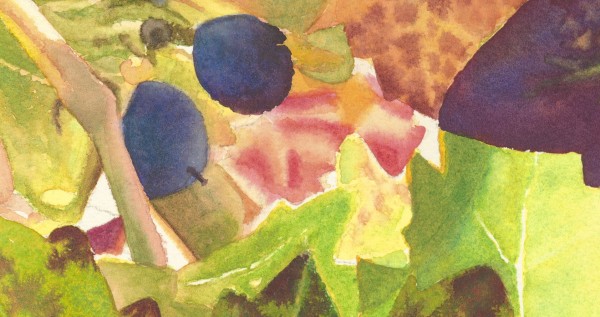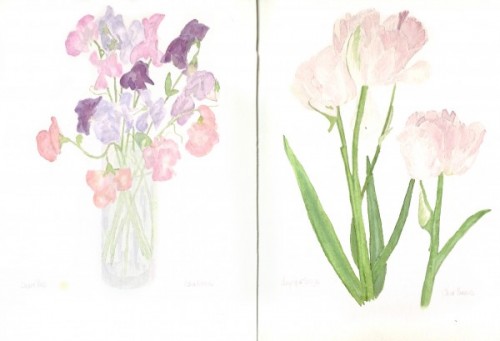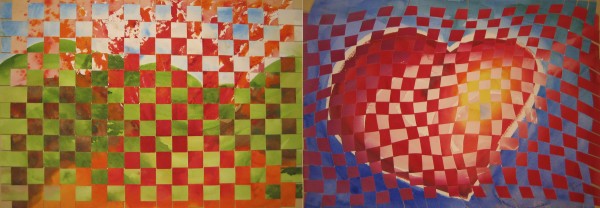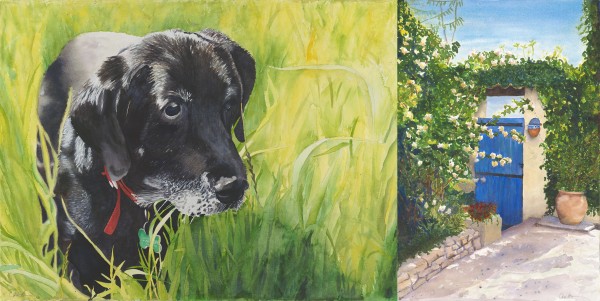August 23, 2016 – Offering the driver refreshments
- At August 23, 2016
- By Cara
- In Art in Process, Life Stories

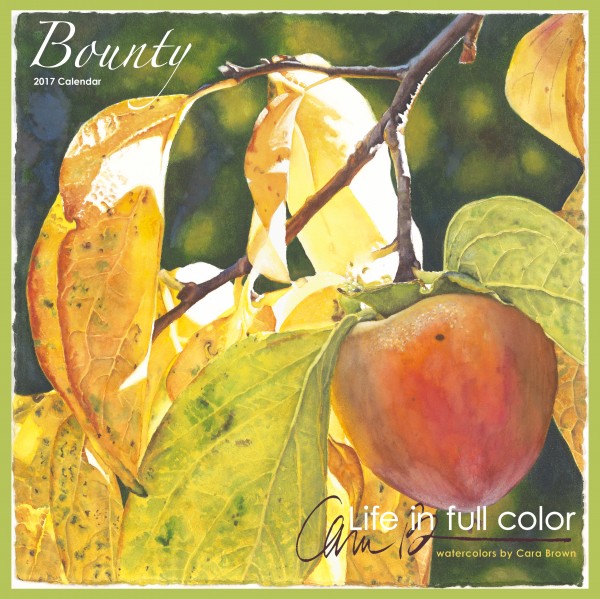
The front cover of next year’s calendar – this time it’s all fruits!
isten to this post:
The Sausalito Art Festival is the weekend after next. It’s a big deal in my art life. Yes, it’s just an art festival, but it’s a big festival, it costs quite a bit of money to do and a whole lot of people will see me and this artwork there. Many of you have found me there. I’m fortunate enough to have been invited back for my ninth year and – as I always do – I want to put up a nice display. This means there’s plenty to do: I feel best when I have a brand new painting to hang; there are postcards and emails to send; my print inventory needs filling in. And this year I got the wild idea to get the 2017 calendar done so I can show it off there. This meant that I had to get the graphic design done – which I do all myself – and get it off to the printer early enough for delivery next week.
I led a Special Saturday class this past weekend after which I was charged up with so much to do with my Sunday. My friend Vicki and I had talked late in the week and she too felt like she wanted to get a bunch done. We agreed to check in with each other throughout the day to help each other stay on track. It so worked! We talked at 9:00 in the morning, at noon and then traded messages before the evening, sharing what we got done. I ended up spending the day weaving between working on my painting, working in Photoshop on the calendar and doing laundry. By working in shorter bursts doing something with my spatial brain, my logic brain and something physical, I was able to stay on track and not get distracted.
You who have been reading these journal entries a while might already get that I have a fairly entrenched internal whip-cracker. I call it my “driver.” I had the sweet idea years ago to give it a new job – instead of Charlton Heston hurling about in a chariot in Ben Hur, I wanted to ask my driver to morph into Morgan Freeman asking Jessica Tandy from Driving Miss Daisy “where to, Ma-am?”. But the transformation is spotty at best. I seem pretty hardwired to fill myself with all these ideas of things to do and then the driver kicks in to get to as many of them as I can. The most painful way this shows up is when I’m trying to finish a painting for a deadline. I have the inspiration, the skills and the privilege of the time in my life to make these paintings, and I can turn the actual painting of them into complete drudgery!
Given all this, Sunday was such a great success. I painted first – it’s the most challenging and demanding of me – so I did it while I was freshest. Then I popped over to Photoshop on my computer where I placed images, moved moons and holidays, chose colors and quotes for each month. When that became tedious, I rotated the laundry and folded a load of clean clothes. Each activity I switched to gave me a bit of refreshment to keep my energy up and the capacity to re-focus when I returned. The best part was that I really didn’t feel like I was making myself do any of it. I don’t mind laundry, but I generally don’t say,” oh, boy! I get to wash the clothes!” But it was nice to notice the feel of the soft warm cloth on my hands as I folded. And since I can only paint so long before what I’m doing starts to really suffer, it helped to also stay engaged with other things that needed my attention. It was close to 4:00 in the afternoon when the pull of my Joseph and our Bo-doggy cozied up on the bed in the pink room overtook me. My eyes and brain were tired and I went to join them. It was Sunday, after all.
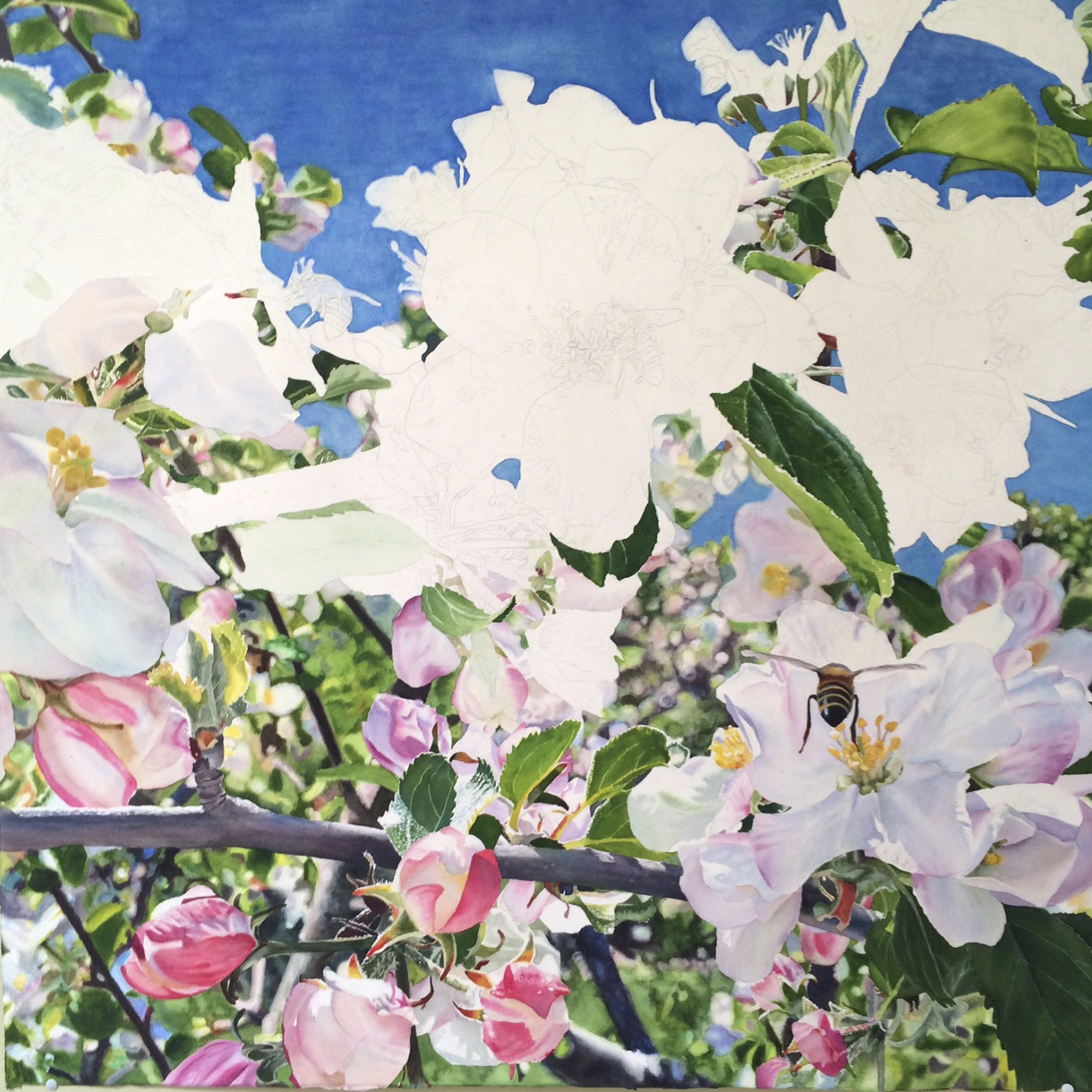
There’s big dissatisfaction with the flower in the center left, so much, I’ m seriously considering cropping the painting along the left and the top. We’ll see…
Thinking about all of this this morning I started realizing how easy it is to wish away our lives. When I’m doing something I don’t want to in that moment, my inner voices, unchecked, can be all complaints, all the time. Like little kids on a car ride they ask, “are we there yet?” Sylvia Boorstein, the Buddhist meditation teacher, says the nature of mind is to be dissatisfied. I so get this. And yet I’d rather not give too much attention to that dissatisfied part of me. I want to cultivate the habit of satisfaction. I want to try to remember that there is always something to appreciate: the clouds or stars up in the sky, or the way the light lands on a tree, a favorite song that comes on the radio – or in this very moment the feeling of the plush blanket on the backs of my legs as I sit here on the couch and type.
There is so much suffering in the world. We are fortunate beyond measure to be living the lives we are in relative safety and with more than we’d ever need to survive available to us ( this is our current reality, at least). I feel helpless knowing that there’s little I can do from so far away to relieve their misery. It seems the least I can do is to realize that any complaint I have is miniscule in comparison and appreciate the life I am living in as many moments I can. That my husband doesn’t clean out the sink like I do after he does the dishes, or that the check-engine light has come on in my car for the third time in a month are barely blips on the radar of human suffering. After all, I have a car and a wonderful man in my life – who provides for me, who adores me and who helps out with the dishes!
It’s tricky because it’s not a good thing to shun any part of ourselves. I think it’s more about allowing this part to be while being aware of a larger, broader reality. This relates perfectly to the process of painting. This dissatisfied mind is exactly why painting is so hard for the vast majority of us. I say often that we have the unenviable job of painting our paintings. While our attention is right down where the brush meets the paper, the part of us whose nature is dissatisfaction is right there, on deck, chiming in. I’ve been painting in earnest for a dozen or more years and I’ve yet to paint for more than a few minutes before I hear that voice. I’ve got to believe that I’m never going to be free of it. So I’m going to play with when I hear it. I’ll notice how beautiful the golden yellow color I’m painting is, or marvel at how interesting the shapes of these petals are, or be curious about how I’m going to sort out painting the fuzzy stems to these buds. There’s always something to satisfy us if we open to it.
And I’m going to plan for other activities to do when I need a break. Being better with my time has been a puzzle and I’m wondering if this isn’t a piece of it. I’m wondering if this resistance to structure that has arisen in midlife isn’t some wise part of me that is refusing to drag myself through this one precious life. I suspect it would rather I keep myself fresh and inspired and appreciating each thing I do as much as I can. Maybe it is the nature of mind to be dissatisfied, but it’s the nature of heart to love – to appreciate. Everyone alive has both a mind and a heart – what I see today is that life goes much better when we heed them both.
With my love,
Cara
August 16, 2016 – Just make beauty
- At August 16, 2016
- By Cara
- In Art in Process, Life Stories

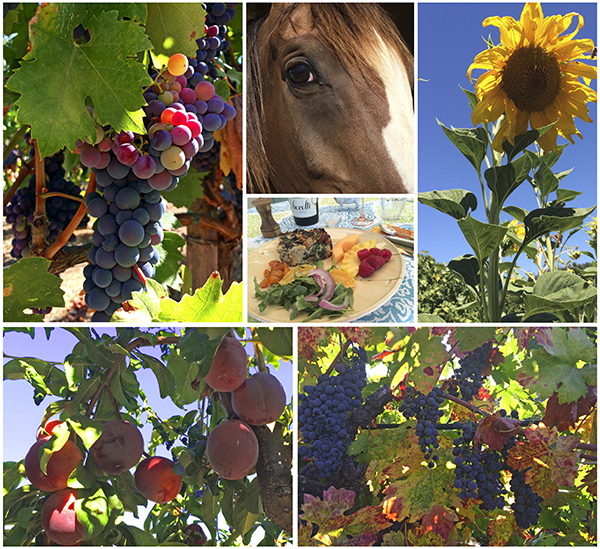
A few glimpses of the richness of our weekend – I just love this time of year – it is SO “full color”!
Listen to this post:
I spent this past weekend on a ranch and vineyard in Cloverdale with six other women-artist-friends. We took photos of the ripening grapes and other fruit, of big, tall sunflowers and of the breathtaking views from up on the hillside. We feasted on beautiful late-summer food and wine, we celebrated a birthday, we swam in the pool, we laughed and shared lots of affection for each other. And – we painted! Originally planned as a weekend-retreat I’d lead, in a more formal and structured way, it changed shape such that I ended up being able to enjoy myself as just one of the group, without the expectation that I’d hold space for everyone or teach or direct the activities of the retreat.
I had no idea how much I needed to spend time like this – to follow my own curiosities and whims without wondering if the others were doing ok. I could spend two hours in the garage drawing a new painting, or obsess on finding just the right cluster of grapes, lit in just the right way that is magic. I climbed up in a plum tree like I was a kid, to take pictures of one of the last groups of plums left hanging. I timidly fed an apple to Bert, one of the horses. I took myself on an early morning walk when I met a sweet little doggy and found an unkempt section of a vineyard that had the most amazing colors of leaves and dark blue-violet fruit. I felt alive in the way I wrote about earlier this spring. And, the feeling carries on in me – time spent this way is restorative.
I do also love time away with my hubby and our puppy dog. But because of the nature of who I am and of our relationship, when we are together I find myself more often in care-taker mode – even if it’s not asked of me. To be honest, if there is one other creature around, it can trigger my inner-care-taker, but she is pretty hard-wired to care for my Joe and my Bo. Time like I spent last weekend fills me up in a whole other way. And I’m so grateful to our hostess Sue who opened her ranch and home to us all – and to Laurie who provided a place to stay for the three of us from out of town. I have a new painting of grapes started and at least a half dozen other strong contenders. It’s energizing for me to have so many paintings in my inspiration pipeline.
I also think that there is something really special and important – at least for me – about spending time like this with other women. It’s not a given that being with a group of women is as easy and restorative as this weekend was. Sometimes group dynamics are fraught with “issues” if there is someone who isn’t “with the program,” so to speak. But not this group of women. We all had an understanding of who was to take care of what and the spirit that surrounded and wove through the weekend – that we created together – was one of generosity and heartfelt care for each other.
When I came home and was unpacking the car on Sunday evening, I found a hand-made greeting card sitting on the dryer in the garage. The hand-written message on the front was this: “Tao – to be truly good you cease fighting the darkness. You just make beauty. – Richard Watson” I thought: wow, isn’t this just the perfect message to cap my experience of the weekend with? The part of me that is compelled to be so very purposeful, who feels so responsible to do my part to right the wrongs of the world, can have a hard time with taking time to just have fun – time for just pleasure. I don’t have a well exercised play muscle. I hardly read for purely enjoyment – I mostly read to learn or grow (though I do love to learn and grow!). I read the movie reviews in the paper every Friday, but we hardly ever go out to the see them. After dinner, I don’t watch TV, I paint, which I love and feel terribly privileged for the time to do, but it’s not play. Painting for me requires energy and focus. I get drawn into what’s going on in the world (pretty easy to do right now) and feel responsible to do what I can – which mostly is just contribute money.
But what if all I need to do is just make beauty? What if making beauty is more than just making art? What if it is how we talk to each other or the space that is created when we gather to paint in Larkspur? What if the beauty I am already making is doing enough? Last night I listened to an interview of an author who wrote a book on Bobby Kennedy while I painted (see what I mean about being so purposeful…?!) He said that Bobby Kennedy recognized that you can’t try to work with people like George Wallace, you have to stand up to them. This plants the question in me: is standing up for what’s right “fighting the darkness?” Or is standing up for what’s right another form of making beauty? I think it depends upon who is doing it and why.
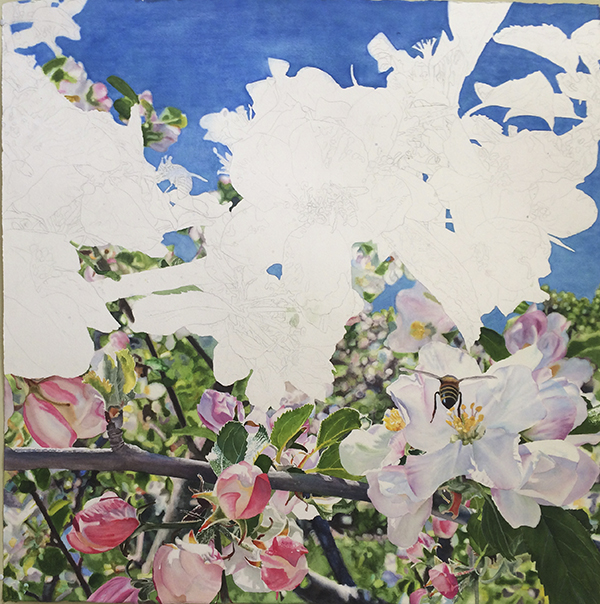
I’m back to this big painting. I so want to finish it for the Sausalito festival. I couldn’t help myself and painted a bee last night!
I’ve come to realize – and must remind myself all the time – that we must do what we are compelled to do – because of what matters most to us at our level of awareness. But anything else isn’t ours to tend to. It’s not good for me to get too emotionally involved in politics or a cause, unless I’m going to get up and take action because I care enough to. Otherwise it feels like fighting the darkness – in an inert way, which is a waste of me. Just because I can, doesn’t mean I must. I must rinse out and re-use plastic bags – because I can’t not. I can’t throw one into the trash that is still usable. This doesn’t necessarily mean it’s your part too. What we care about is personal. It’s good to know that there are others who take care of things that are not mine to do.
It relieves the part of me that feels like there’s so much that needs doing in the world to know that there are forces at work in the evolution of our planet and humankind that are way beyond the power of any one of us. And yet we each make a contribution towards this evolution in our choices and in our actions. Those choices and actions are personal, they are our own. And I have to believe that having weekends like I’ve just had and making the paintings that will follow are positive contributions. I tell myself that change comes in its own time. To the part of me that feels obligated to fight the darkness, I tell that I’m here to make beauty – which to me means many things – the most obvious and visible is that I paint my love. You too?
With my love,
Cara
July 5, 2016 – The choice we DO have
- At July 5, 2016
- By Cara
- In Art in Process

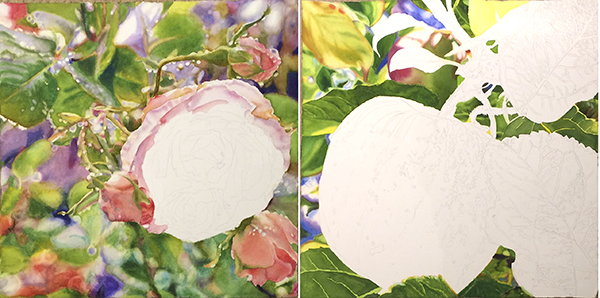
The two paintings I’m working on. I’m loving having this rose to paint when I just want to play. The other is of an apple, I’m planning for the 2017 calendar.
Listen to this post:
This morning as Bo and I were taking off down our street to head up the hill, we ran into Ed – a neighbor – washing his fishing boat. I asked him if he’d been out fishing. He said yes – and that it wasn’t very good. The wind has been terrible, whipping up big waves that tossed him about, banging him against the console of the boat. He’s come home with his arms aching from holding something heavy all day – and not much fish. He said he used to have bigger boats that would take it but it’s not worth it anymore, things have changed. He said “what can we do but go on?” To which I said “we really do have no choice.” He agreed, we wished each other a good day and Bo and I took off. This is how it is, isn’t it? Life changes, we may complain and grouse – and we go on. Fighting reality is ultimately futile, we have to accept and adapt – some of us more readily than others. To the part about not having a choice though, I had another thought bubble up. There is something we can choose – our attitude. We absolutely have a choice as to how we show up, who we show up as, and how we frame reality in our minds. This is sounding very Viktor Frankl.
And it brings me back to a conversation I had with my niece and her partner when they were here a month ago. They are in their early 20’s and both identify as “gender queer.” Born female, they experience themselves as neither masculine nor feminine, but “gender neutral” – at least this is how I understand what “queer” means. Until a couple of years ago Leigh was called Hannah – her first name. We watched her evolve from a little girl into a teenager who was exploring her own style with long dark hair, sometimes with a big blonde streak, strong eye makeup and very bold, black eyeglasses. In her late teens she cut her hair very short, wore much less makeup and left skirts behind. Now she wears her hair very, very short, no longer colors it and wears clothes more closely associated with what we’d think men would wear – and we now know her by Leigh – her middle name. Leigh doesn’t identify as a woman and I don’t experience her as one. It is such a privilege to witness someone so close to me evolve or unfold, showing the world the truth of who they are. She is so at home in and complete with this expression of her self – of her gender, or rather her lack of gender that my mind is caught by hearing and using words like “she,” “neice,” “daughter” and even her given name – Hannah – in reference to her. Leigh agreed – she doesn’t find herself inside these terms either. What an experience to be on the edge of human expression beyond the extent of our current language. No doubt terms will evolve and one day be commonplace, and until they do, for convenience sake, I’ll keep using the feminine pronouns.
While they were here we were talking about how they didn’t choose who to be, they just were. They didn’t choose to love each other, they just do. These aren’t things that we do in an eeny-meeny-miny-mo kind of way. I believe that who we love, and our own experience of our humanity are factory installed. Then Leigh added: but we do choose how we behave, the actions we take, what we say – we choose how we are with who we are and what we love. Leigh could hide, she could resist, she could even reject herself as most LGBTQ people have for centuries – millennia – and many in the world still do. But it is in choosing to allow ourselves be who we are and love who and what we love that we change the world. We push out the edges of acceptance. Those on the front lines do this with great courage and danger, even – and they still choose to do it.
I have so much admiration for these two young people. Leigh and Lena are remarkable: smart, creative, funny, joy-filled, tuned in, purposeful. They care about our impact on the planet and are working to change it more than anyone else I know. My hope for our future is stoked by the fires that burn in their hearts, their brains, the light behind their eyes. And their commitment to each other is more complete – they have more fully surrendered to the good of their union than just about any other couple I know – most of whom are decades older. And, I’d venture to say that if they didn’t exercise their freedom to express themselves so genuinely, that some of their energy and passion for each other and the world would be trapped under the restraint. We are all better off because of their choosing to be who they are – and love who and what they love.
These two are a bright, shiny example – in the most important way – of what I’ve been sharing with you these past several weeks – how vital it is to live our love, be our love and paint our love. In a conversation with two of my coaching sisters last week, Maralyn, who works with people to have real, intimate, courageous, human relationships – said that this is how she “paints her love.” For all of us doing our purposeful work – we are “painting our love.” She has expanded for me what constitutes our “canvas” (though we watercolorists generally paint on paper) and what it means to “paint.” Painting our love is even more than art-making. But this not to trivialize painting! For many of us painting is closely aligned with who we are – we must paint.
Today I hung eleven paintings in some offices at our local community college for the next two months. The curator who helped hang the art suggested that I paint some abstract paintings – “to give gallery owners what they want.” My immediate reaction was – I won’t paint to give gallery owners what they want. I paint paintings that people can – in their minds – fall into. My art asks of me to be about beauty, light and color – and emotion. I know that what I paint isn’t what many who are finding great success paint, but I am choosing to be who I am, choosing love what I love, choosing to paint my love.
It’s in us, each of us – it’s in you – who you are and what you love. By honoring who you are, choosing to act accordingly, you further the course of humanity. So what are you waiting for? I’m here to support you.
With my love,
Cara
June 2, 2015 – The spirit of Kauai
- At June 2, 2015
- By Cara
- In Art in Process, Life Stories

Listen to this post:
I first came to Kauai about this time of year in 1997 for a friend’s wedding. I stayed at the Hyatt Regency – a beautiful, lavish resort on the south shore. I had United MileagePlus discount coupons for this hotel – it’s funny how accidents of circumstance can end up changing our lives! I had been back a year and a half from Paris and hadn’t yet met Joe, so I was here on my own, amongst lots of shiny wedding bands and families with small children. My friend’s wedding was in a garden along Hanalei Bay on the north shore and we went to a luau on the east side – giving me a taste of a lot of this lovely island.
The next time back was two years later. Joe had just finished chemo and we were looking for a vacation spot to start his healing. He’d been to Maui, but never Kauai. My first trip here introduced me to Kauai’s rhythms – peaceful and soothing. We stayed in an end-unit condo with a sweet, private little garden, walking distance from the Hyatt where I had stayed. We discovered a hike along the coast, starting at Shipwreck Beach in front of the Hyatt. The web of trails head east along a bluff, with amazing views of the ocean and the south coastline of Kauai. We hiked every morning and then came back and talked, really talked. His journey through cancer treatment started six days after our first date and the next six months were a whir of emotions and the realities of cancer treatment – infusions, a hospital stay, injections at home, many restless nights. In that little garden condo we took the time to share with each other at Kauai’s pace.
Journeys through life-threatening illness shift things in us – after cancer, Joe resolved that we’d come to Hawaii often. Since then, it’s been at least once, many times twice a year. Except for one more trip to Maui and another to the Big Island – both in the following two years – every trip back has been to Kauai. In 2004, on a whim, we walked into Island Pacific Properties in Koloa town and met the broker, Stephanie. We left that trip having taken a big risk – we’d made an offer on a house! It’s always been someone else’s home, we’ve never furnished it so that we could stay there, but owning a house on Kauai has anchored us here even more. What seems more important to me is that through Steff, we’ve met so many wonderful people. When we come here now, we see old and new friends. It’s so much more than a vacation spot.
Because we really love sunshine, we’ve always stayed on the south shore. I’ve been here 10 days now and I’ve not ventured any further north than the airport in Lihue! Our time here is spent “trying on” retirement. We’ve always stayed in a place with a kitchen, so we can have meals “at home” if we want. We still do the same walk along the coast, but now we know to look for sea turtles in the water and often go all the way to the next beach – Mahaulepu – and go for a swim in the spot inside the reef break. On calm days it’s almost like a swimming pool. Joe golfs and I paint, we read and do a whole lot of not much else. There are many treasures on this island we’ve yet to experience, but somehow we’ve lost the impetus to be explorers. What we come here for, more than anything else, is to just be.
I take walks along the shore from the Hyatt headed west sometimes too – and take pictures of the tropical flowers in the lush gardens of the resorts and vacation homes. So many of my paintings have come from these walks.
It’s been interesting to watch things change: new condos have been built in some of the empty spots, run-down places re-done and the gardens change too. For some reason, every year for the past five or so, the water lily ponds are going away. One year there are no more plants, the next there isn’t even any water in them. I don’t know if they are too much to keep up, but I’m so glad that I have been able to capture them in paint! None of the ponds I’ve painted below exist anymore.
As I mentioned in my post about “home” a few weeks ago, Kauai is one of ours. It has me wonder what it is about a place, the spirit of a place – that meets us, compelling us to come back again and again, developing a relationship with the place that is as real as any relationship. As I write this, I’m in my friend Robin’s studio – in her house in Kalaheo – a bit up-country from where we stay closer to the ocean. She paints beautiful, color-filled oils of this heavenly place. I love having a real artist-friend here. We inspire and support each other in a way that, somehow, I’ve not found with anyone at home. She’s working on a painting of a succulent, finding her way through the shapes and colors and I’m taking a break from struggling through the lily pond painting I’m working on to write to you. Coming through the open French door are the sounds of the breeze in the palm fronds and the calls of the tropical birds – including the roosters – and even the bleat of a goat! This is absolutely paradise.
We’ve talked about living here full time – even as an adventure for a year. So far, the pull has not been strong enough to up-root us from Northern California, where we were both born and our lives are still centered. Nonetheless, there is something here for us, that lives in us when we are back “home.” When we went to see the George Clooney movie, “The Descendents” at the Fairfax Theater, we felt it. There is a scene where his character flies with his daughters from Oahu to Kauai to see the family property. As they are walking in from the jet-way into the Lihue airport, I felt in me and sensed in Joe a combination of recognition, knowing and longing. We felt Kauai in our bones for a moment. This place fills a need in us that isn’t filled anywhere else – even in the very-special place we live.
Saturday night we went to the salt ponds to watch the sunset. Joe was curious what the people were doing a short distance away. Following his intuition, we went to check it out. His respectful, reverent way of asking about it inspired Emma, a native Hawaiian to take the time tell us all about it. She’s the third generation that has been tending the salt beds – the only ones on Kauai. We saw how they carefully re-make the beds with smooth black mud every year and then carefully bucket the salt water from the wells into them. The sun evaporates the water and in a number of weeks salt crystals form, which are then gathered up and dried. Her son and niece and grandkids were there, participating in the traditional practice, carrying on the knowledge. When I asked if they sell the salt, with pride and honor, she told me they only give it away. Then she gave us some of her pink salt from last year – white salt that had been mixed with Hawaiian red dirt. She told us this salt is medicine.
The clouds were spitting rain as we left, feeling like we had just been blessed. It’s still not coming to me how to articulate what it is about the spirit of this part of this island that we connect to, but it so does. We are renewed and inspired here. The air is soft on my skin. Thank you, Kauai.
Aloha,
Cara
May 19, 2015 – Windows to the soul
- At May 19, 2015
- By Cara
- In Art in Process, Life Stories

Listen to this post:
For some reason, I’ve been really resistant to wearing glasses to read, even as my eyes are going through the aging process that affects nearly all of us – I’m becoming far-sighted. I put off wearing drug-store cheaters to read as long as possible – until sometime after I turned fifty. And I still often go without them – squinting to see, which means sometimes I’m lectured that this will wrinkle up my face. Maybe because I’m a visual artist, maybe because what I most want to impart to the artists who come paint with me is that they can expand their capacity to see, but I’m preoccupied with vision!
Sometime last year, my dad was diagnosed with early stage macular degeneration. He was advised that all his children over 50 should be tested too. I went right in to have my eyes checked out. The optometrist found a few very small drusen on my retina, which I was told was normal for someone my age. But then later that day – a Thursday – I got a voicemail from her. She said she upon review of the photos taken, she saw a small hemorrhage on my retina. A small hemorrhage? I tried calling back, but missed her and was told that she was out on Fridays. So I spent the weekend wondering what it might be like to not have my eyes. Not only does eyesight offer us freedom and independence, but it is color and light and allows me to make my paintings! Then, I went to a Speaking Circle and realized the connection between human beings that happens when eyes meet – so much is conveyed across space from one heart to another through our eyes! I’m guessing that vision-impaired people connect hearts in other ways, as the other senses become more acute. But the thought of finding this out first-hand was crushing.
I went back to see what she saw. When the photo of my retina was expanded so it was larger than the 14” monitor, the “hemorrhage” was about the size of the head of a pin. Ok, so I’m not going to get all freaked out about that tiny thing. Whew. But the brush with the possibility of losing my eye-sight has me even more tuned in to seeing.
I was online one evening about a month and a half ago and saw one of those ads, like the-5-foods-you-should-never-eat-again. It was 10-minutes-a-day-for-one-week-to-regain-20/20-vision. It hooked me, I bit. I watched about 25 minutes of the infomercial video before the hype-i-ness of it wore me out. But I got enough information to start an online search. I found out about what’s called the “Bates Method.” Dr. Bates was an ophthalmologist, who, in around the turn of the last century, began developing exercises to help people improve their eyesight without glasses or surgery. An important aspect of this work involves resting the muscles around the eyes, which relieves strain that impairs vision.
I bought a book on it and have started, sporadically, to do some of the exercises. I’ve been almost entirely without my cheaters for over a month now. My near vision is still blurry, but it has improved slightly and I’m amazed at how I can see well enough to read – without squinting – which is itself another form of strain. One of the things they suggest you do is, when walking or driving or moving through space in some way, to look through your peripheral vision to see the trees, bushes, buildings seem as if they are in motion. When I do this, it’s as if I’m staying in one place and the rest of the world is moving by me. It’s the coolest thing! This has given me moments where I experience the three-dimensional nature of our world very acutely. On a walk with Bo in our neighborhood I saw a big tree and the space it occupies, almost as if it’s a holograph.
All of this leads me to the possibility that I can shift how it is that information is received in my brain through my eyes. It’s as if I’ve been seeking out, hunting even, visual input. What has developed is the desire to simply allow it to enter, in a more passive – yes, even feminine – way. It’s quieter, more meditative and it brings up another of the distinctions we learned in the leadership program I wrote about last week – particles and space. We spent an entire retreat attempting to focus instead of on the particles – the “things” all around us – to focus on the spaces between the things. In art it’s the “negative space.” In the big tree it’s seeing the distances between the branches as they go up and out into space. But this can be difficult – “things” captivate us – they really grab our attention with their “being-ness.”
I’m finding this challenging to articulate. It’s a shift in perspective and perception that’s hard to describe, but I’m compelled by it. I am curious as to how it might change the art that comes through me. I do know that my ability to see what’s really there, in a reference image, or in real life, has grown immensely through all these paintings I’ve done. It’s also what I most want to invite in other artists in their learning process.
Our retinas transmit 10 million bits of information every second to our brains – wow, every second? In order to not be completely overwhelmed by this information, our brains have a filter that processes that information based on what we have already seen, what we believe and value. Quite often, I watch us – yes, me too – as we make our paintings – we make decisions in color and shape and brush stroke based upon what we think we see. It takes slowing down, resting our eyes on what we are looking at, to allow what’s actually there to go beyond the filter and register in our brains.
The first time this really crystalized for me was when I was painting “Fauchon Eclairs.” My inclination was to paint the shine on the chocolate glaze a lighter version of the dark chocolate brown. But something stopped me. I made a hole in a piece of paper and put it over the shiny part of my reference image. It was a violet blue! Ok, so I trusted what I saw and painted it a violet blue. No one has ever asked me why I painted it blue, or even noticed for that matter. I can look at this painting and shift my vision from seeing shiny, brightly colored pastries to seeing abstract shapes and colors. Can you?
When I first started really painting, I noticed this shift happen all the time, even when I wasn’t trying to make art, but just going about my day. I’d see the light on a leaf and wonder how I’d paint it – or clouds, or the shine on the hardwood floor. Now, I hear the same thing over and over, from people who are new to painting, too. We really notice what is around us, even without intending to. To me this is a waking up. It’s a paying attention in a more careful and reverential, and even honest way. It makes me wonder how much our capacity to see can keep growing and what that might make possible – not just in our art-making, but in our lives. And it has me profoundly grateful for these incredible organs of perception – our eyes.
Love,
Cara
May 12, 2015 – Failing and recovering
- At May 12, 2015
- By Cara
- In Art in Process, Life Stories

Listen to this post:
When I came back from my stay in Paris in 1996, I settled back here in a house in San Anselmo (in Marin) and worked in San Francisco. I either took the ferry across the bay to the Ferry Building or the bus across the Golden Gate Bridge. Not too shabby either way as far as commutes go! I remember warm evenings in the summer sitting outside on the boat, watching the city draw away from us, feeling the magic of the uncommon warmth (it’s often windy and chilly in the summer on the Bay). And in the winter, I liked to get a window seat on the left side of the bus, so I could watch the sun set out over the Pacific Ocean as we headed north over the bridge. I thought to myself: people travel thousands of miles to see this – and I get to see it all the time.
By about 2003, after meeting Joe, getting married and going through unsuccessful fertility treatments, the magic had worn off. I remember saying to Donna – who was officially my “therapist” but is what I’d truly call my God mother – that getting on that bus felt like “slamming my soul against a concrete wall.” I was searching for something else to do for work that would keep me on this side of the bridge. I suggested one day that I could do bookkeeping. To that she said “you are a teacher.” (It is such a gift to have people in our lives that see who we are before we do.) She pointed me to CTI – the Coaches Training Institute. She had another client who was going through their program and thought I might be interested.
CTI is one of the best coach training organizations in the world and they are headquartered right here in San Rafael. I went home and read the curriculum on their website and knew it was me – working with people as they grew into the lives they were called to live was where I wanted put my energy. It took a couple of years before I started – April of 2005 – a decade ago! When I was in the third of five courses, one of the leaders saw something in me and asked me to consider doing CTI’s leadership course. It’s a 10-month, nearly $10,000 program. Holy cow! I was scared, of the time and money commitment, but also of what it would ask of me. I was still gripped by that stage-fright! I started Co-Active Leadership on my 44th birthday in November 2005. The “me” that emerged in the next 10 months can never go back inside the box she was held in. It expanded my consciousness, my sense of self and my impact. I learned the value of my voice and my point-of-view and the power of creating in partnership. It’s an amazing program.
We learned practical distinctions that I still call upon all the time. I’ve been thinking about one of them a lot lately – recovery. We learned that the deal is not to avoid making mistakes, having missteps, going off track. The deal is how we recover from them. Through high-ropes exercises with a partner, we got in our bodies how even dangling helpless from a rope, there is a way to pull back up and get going again. And, that it almost always takes the help of others.
Recovery is not just what we do, it’s a mind-set. If we expect that things will go awry at some point and we take responsibility for the situation, we have a whole different set of capacities to handle it. If we hide, deny or crumble under the challenging circumstances, it doesn’t go so well. It’s hard to do. Our egos don’t like being responsible for what goes “wrong.” It’s called failure – in our heads and outside them too. We are geared toward success, but we need to “fail” to be strong. Even more than that, it’s how it goes in life. We will fail. We can learn to see failure as a means to learn and grow.
I’m incredibly inspired by Alison Armstrong’s commitment to recovering well. When she and her husband or other partners in her life “blow up the laboratory,” as she calls it, it is her commitment to work through what happened between them so fully, gaining all the learning and insight from it she can, so that in the end she’s glad it happened. This is recovery in the spirit that we learned in leadership! And it’s given the world Alison’s work – which has brought freedom, understanding and peace to thousands and thousands of relationships.
Of course, these days I look at almost everything through the lens of creativity and how I can be a better teacher. I am largely self-taught – besides a few workshops and adult ed classes, I learned to paint by finishing every one of my paintings. When I hit a spot where I thought I’d ruined it, or when it just looks so awful to me that a voice tells me it isn’t worth continuing (and this happens with every painting – still!), I’ve stuck with it and figured out what it needed. Sometimes help comes from my reference image. I say to the painters in my groups “we are not slaves to our reference photos, they are our servants.” The photo, to the best of the camera’s ability, captured the light, the color, the shapes of our subject – in the moment we were inspired by it. To that end it can be instructive to us in our painting process. So, I compare the photo to the painting which tells me what’s needed.
I’ve learned to be bold. Painting Reach! several summers ago, I left the sky for last. I envisioned a smooth lovely wash of blue, but it was a warm day – it was drying fast and ended up all splotchy. I panicked that I’d ruined it! I took it out on the metal patio table, got a 3” house painting brush from the garage, mixed up several blues and a violet and slathered the paint on. Here’s the before and after. What I ended up with was a “life in full color” sky, and a much stronger painting than if I’d been “successful” with the pale wash.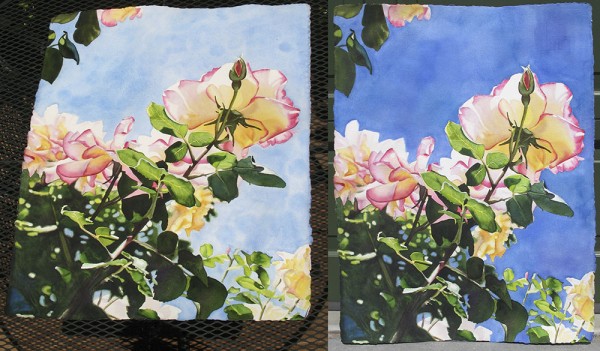
With August Bounty, I didn’t have a good drawing of the ivy – the image was dark and I couldn’t see to draw it well. I tried to make it up as I painted. What I had painted was so bad that, though I had ¾ of the ivy painted, I put the whole piece of paper in the kitchen sink and sponged it off. I dried it flat, took a new, lighter photo of the ivy, re-drew and re-painted it from the start. That’s recovery! There are some green stains that can be seen through the tan-colored paint over to the right (see the detail photo) – which I think actually makes it a bit more interesting. And – that I’ve done this has made me a better artist and a better teacher.
I joke often about offering a workshop called “Can this Painting Be Saved?” Artists would bring the work that is tucked away because they don’t like what they’ve done. We can’t be sure that every painting is one to be “saved,” but based on my experience, I’d bet many are. And our creative capacity expands by even attempting it. This is the real gold to be mined.
Whether it’s a tossed aside painting, a relationship that’s hit a bump or – for me – the eternal desire to take better care of myself, I’m banking on the creative capacities that lie in committing to recovering fully. I invite you to join me.
Love,
Cara
April 28, 2015 – A home for the unwanted
- At April 28, 2015
- By Cara
- In Art in Process, Life Stories

Listen to this post:
I just finished another painting and part of me can barely stand to look at it and call it mine. This part of me worries that I got the shadows on the rose murky, the yellow is too intense and brassy. It tells me parts of the leaves are clumsily painted and the background is unrefined and messy. After all these paintings, which have received such generous appreciation, you’d think that I’d be more able to take pleasure in the results of all the work I put into them! There is a pattern which has revealed itself in my relationship with my work. As I’m painting and when I first finish it, I have to force myself to not just see all the parts that vex me. They stick out and grab my attention – though there is another part of me that sees my work more holistically. This part knows when I’m on the right track and finally, when the painting is done. At this point, I take it in to be scanned (for giclee prints) and to be framed. Framing art always does something. It elevates the art and provides me with just a bit of distance from the hyper-intimacy when I’m in the middle of painting it.
Then it takes sometimes a few months to start to forget all the places in the painting I struggled, making a space in my perception to receive the spirit of it – I can begin to appreciate in it what the rest of you do. I’ve had the experience of opening some of the high resolution scans on my computer, of paintings I’d done some time before – and zooming way in, where I can see it even more closely than when painting it – and I actually fell in love. I took joy in the colors, the edges and shapes of the washes and passages and its essential abstract nature. It’s an entirely different state of mind than the one I had when I put brush to paint to paper to make those shapes. It’s even hard to fully get that I was the one who made these marks.
I’m fascinated by this whole process. We, the art-makers have this, in some way, unenviable position. To make the art, we must operate close in, right at the point of creation. This place is messy and uncertain, and the voices in our heads chatter about what we are doing. I hear them all day long on Thursday and Friday in my painting groups. There is judgment and uncertainty in each of us, to varying degrees, that is absolutely unrelenting.
Maggie, a perceptive and thoughtful woman in my coaching group posted this, written by Matt Licata, in our Facebook space last week:
“You want to share your joy, your happiness, your peace, and your love with others. It is so natural to want to uplift those around you. Perhaps the greatest gift you can give to another, however, is your willingness to provide a home for the unwanted within you.
For when you are in direct contact with your own grief, loneliness, rage, and confusion, an attuned field of love emerges in the space between, granting an ancient permission for the ‘other’ to finally meet these unresolved energies in themselves.
Look carefully and see the subtle burden you have placed on those around you to compensate for the longing of your unlived life. To re-own this burden may be the greatest act of kindness you can offer this weary world.
It is by way of this holy re-embodiment that you will be crafted, cell by cell, as a pure, alchemical vessel in which the wildness of love can emerge here.”
When I read this, I found it so beautiful and consoling. A home for the unwanted within me – I think this is part of what I was talking about in my post about “home” two weeks ago. It also speaks to what I’m exploring here. I don’t really want the part of me that picks apart my art in process. I’d rather be free of it, thank you very much! I’d rather the art making process be blissful, peaceful easy – just the pure joy of playing with colors and making shapes.
And this is just one of the “unwanted” parts of me. There’s the part that lost her temper on Friday, and did the unthinkable – snapped at one of the painters. I’d much rather have a sweet and even temperament all of the time. I don’t want the part of me that is so eager to cram all that she can into each minute and doesn’t leave enough time to always be on time. I’d rather be actually early, arriving calm and ready for anything. I don’t want the part that really, really craves sweets in the evening, which can wreak havoc with my mid-life sleep patterns. I’d rather be happy eating only healthy, good-for me foods, 100% of the time. My grief at not being a mother, my frustration with the things that bug me about Joe, my unwanted list goes on…
Writing this has me see how silly it is to “unwant” any part of me. To have a whole range of parts and emotions – wanted and unwanted – is to be human. So then, what does it actually mean to “make a home” for what is unwanted in me? What comes to me when I ask myself this question is, practicing noticing these parts when they show themselves, realizing that they are “unwanted” and then practicing letting go of the idea that any of it “should be” any different than it is. All of which will – hopefully – allow me to soften towards all parts of me and not interact with others when these parts are running the show. Ultimately, what I’m feeling called to is to be able to claim these unwanted parts as mine. Open-heartedly including them as me. Of course I will not do this perfectly, which creates a repeating loop, start again with noticing the unwanted parts…
This is just what I’ve learned to do in painting. If I took direction from my fear and judgment about how it is going in my paintings, I’d never paint! I’m determined to paint in spite of this chatter – which is just one way to live my life accompanied by what’s “unwanted within.” My hope is that as this capacity grows in me, and I can name it for artists who paint with me, it ends up having an impact on others – in the studio – and out. And as each of us does this, the world evolves. My sense is that it’s slow work and progress isn’t easy to observe. It’s only upon reflecting back in time that it’s revealed how the ability to be with what is has grown, and more and more lightness has settled in – for me, this is what Matt Licata calls the “wildness of love” emerging.
Love,
Cara
March 31, 2015 – What has us step up and commit?
- At March 31, 2015
- By Cara
- In Art in Process, Life Stories

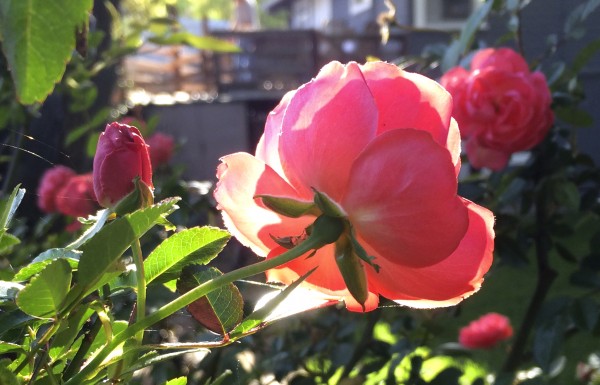
A photo I took, over the top of a fence on my tiptoes!
Listen to this post:
Today marks six months of writing a post to my online journal every, single Tuesday. Through the holidays and the busy times and the weeks I thought I had nothing to say, I’ve found something and I’ve written and posted. Yay to me!
I celebrate this mini-milestone because I’ve spent the vast majority of this life thinking I am not a writer. (I shared with you my history with writing and why I write in a post late last year.) I also celebrate this because I’ve been telling myself a story that I’m not a stick-to-it person. I love to start things, but the discipline of seeing them through has not been something that comes naturally for me. I have no problem committing to marriage or a job working for someone else, but when the only consequence is that I let myself down, it has been a whole other story.
I would have thought there would be no great fallout if I just petered out on posting every Tuesday. Well, that is except self-induced shame at having an abandoned blog. Encountering such blogs – where the last post was years ago – and that story about my lack of discipline – have kept me from even starting. Until now.
Yesterday I read a recent Seth Godon post – it’s short – here it is:
We spend way too much time teaching people technique. Teaching people to be good at flute, or C++ or soccer.
It’s a waste because the fact is, most people can learn to be good at something, if they only choose to be, if they choose to make the leap and put in the effort and deal with the failure and the frustration and the grind.
But most people don’t want to commit until after they’ve discovered that they can be good at something. So they say, “teach me, while I stand here on one foot, teach me while I gossip with my friends via text, teach me while I wander off to other things. And, sure, if the teaching sticks, then I’ll commit.”
We’d be a lot more successful if organized schooling was all about creating an atmosphere where we can sell commitment (and where people will buy it). A committed student with access to resources is almost unstoppable.
Great teachers teach commitment.
This idea of “teaching commitment” keeps sifting up to the top of my mind since I read this. What does it actually mean to teach commitment? And is it related to this idea of “accountability” that I said last week I’d explore today? Honestly, I still have no compelling way to talk about accountability. And, if I’m not feeling it, I’m not going there!
Last night I saw a cartoon and link to a post on Facebook about how little freedom and autonomy today’s kids have. It was worth a quick read and seemed related. But, as much as I absolutely resonate with this idea of “free range kids,” having not faced the challenges and pressures of making these parental decisions myself, I’m staying away from publicly offering any opinion on the subject!
This brings me back to this whole idea of commitment. I’ve written to you consistently because I made a commitment to do so. In a session with my coach Lissa Boles last September, she challenged me to start writing and posting – regularly. Something in me knew that doing this would be good for me. So, with my fear in tow, on October 1st I wrote about our very old oak tree and its brush with being cut down.
As an art teacher, I am called upon to teach technique – how watercolor works – how to handle the paint, water and paper to get the desired effect. It’s probably the most obvious and expected reason to seek out a painting teacher. But reading what Seth Godon wrote has me want to be a great teacher – I want to teach commitment. And I’m not sure I know how.
This morning, poking around looking for what to write about, I found some stream-of-consciousness “freewriting” I did last August. Here’s an excerpt:
It’s what we want. To be able to make beautiful work, or compelling work, that excites us and lights us up. It may start as an escape, a break from the other parts of life, especially when these other parts are challenging. Painting saved my life. Took me from my grief of not being a mother and has given my life focus and commitment and satisfaction. It’s amazing how different I am, how much of myself I have access to and freedom with. How much space I take up, how much more alive I am.
This is all possible for everyone who wants to. Desire is huge, it’s the fuel. It doesn’t have to be big, fiery and visible. It just has to be enough. “I want…”, “I would love to…”, “if only I could…” Just a small, timid peep is enough. It comes from somewhere deep in each of us. And what’s needed is an environment where it can be brought out. I know watercolor. I can teach the skills, I’m good at it. I’m good at showing how it works. But ultimately the skill has to come in the doing of it.
Desire is the starting place, it’s the seed. But the “doing of it” – painting regularly, the painting-that-changes-our-lives – takes this commitment. Seth used the word “atmosphere” I used the word “environment”. Environment is key. There are so many stories I hear of teachers who have damaged the art-maker in people. I’ve lived a few of these stories too. These are environments that have us turning away from any commitment. So what environment fosters that commitment, what “sells” it?
Sometime in the last year I heard this come out of my mouth: “I’m made to be a teacher. It’s my experience that the particular way I’m designed, where I am the most “me,” is in accompanying others in their creative unfolding. I’m a good watercolorist, and there are lots of watercolorists who make beautiful and skilled work. I keep painting because – well, there are paintings in me, *and* because, in order to stay vital and alive as a teacher, I must stay in my own process. I must ride my own edge.”
Though my painting has its ebbs and flows, the work that comes through me is evolving and I’m all in, I’m committed to it. Does this matter those who come paint with me? I wonder how this impacts the teaching environment I create. I so wonder. Relatedly, I’ve recently come to the realization that I am most alive as a teacher when teaching those who are truely committed. It’s just not the same if painting is a pleasant past-time. Committment feeds off of committment.
I don’t have a tidy ribbon to tie at the end of this post today. The questions I’ve asked here are quite alive in me. If you have thoughts about creative environment and your commitment to painting – or to anything really, I’d love to hear them. Please share.
Love,
Cara
March 30, 2015 – “Eternal” – two videos
- At March 30, 2015
- By Cara
- In Art in Process

The last 10 minutes of painting – hear me talk about painting technique – and a bit of the story behind how it came to be:
[youtube=http://youtu.be/hioY34rZ97M&w=600]
Now, watch as I painted “around the clock”
[youtube=http://youtu.be/TjgOi_lSLWY&w=600]
March 24, 2015 – Creativity and Tension
- At March 24, 2015
- By Cara
- In Art in Process, Life Stories

The first time I ever painted was in June of 1992. My mom and I took a Saturday class – painting flowers in watercolor. I painted a somewhat awkward blue iris – and I fell in love – with the playing with the colors and the texture of watercolor paper. I’d been bitten by the bug! Over the next few months, on my own, I painted several small paintings of flowers without backgrounds. Two of them are above. I observed, drew and painted from live flowers sitting in front of me. And then I hardly painted at all for seven or eight years. A lot happened in my life in those years: divorce, job change, living in Paris, buying a house of my own back home in Marin, meeting my Joseph, his cancer, moving again, getting married. In 2000, when I found myself working for a company a 2-hour drive away, I arranged it so I could work from home three days a week. This gave me some extra time and I picked up painting again. I began working from photographs and painted my first “fuzzy background.” But I would still not paint for sometimes months and months. I started a piece and then hit a phase in it when I just hated what was happening, felt stuck and I’d put it away and not pick it up again for a long time.
In the spring of 2005, I did a seven-day silent meditation retreat at Spirit Rock in Woodacre, right near where I grew up. The format of the retreat was such that, after a day to fully arrive inside ourselves and the retreat space, we had five hours a day to spend, on our own, with our creative practice. Five hours with myself and my watercolors – no one telling me what to do and no one to talk to, to distract myself. Heaven! I brought all my supplies and my unfinished work – one of our dog, Bud and another more loosely painted, of a vignette from Quarante, a village I’d visited with my mom and dad in France ten years earlier. One sunny day, I sat outside in my straw hat, with a 12”x16” block of watercolor paper and painted, one quick painting after the other, with a 1” flat brush entirely with my left (non-dominant) hand, letting whatever I wanted to paint come out, without a lot of thought. After that, back in the studio, the idea arrived to cut two of the paintings in strips and weave them together – one in soft greens of the surrounding hills and the other of a rough cross-section of a volcano erupting – all in reds, oranges and browns. The next thought came to combine two others – a heart and a fetus in utero – into a piece that was moving and healing. I wove the unrealized hope of being a mother into my emotional center for safe keeping.
There was a large piece of cardboard – like from a refrigerator box or something – leaning up on the wall of the studio. Someone had carefully drawn what looked like a crack in a big hunk of stone vertically down the middle of the cardboard and then scrawled across it “Don’t be afraid to murder your little darlings.” I was taken aback by the affront in this, and it gave me permission to dive in and just ruin the painting of Bud the Dog – which is just what I needed to get over my paralysis and actually finish it. I did the same with the painting of the French village which we know now as “Blue Door.”
I look back on that retreat as a really fruitful time for my creative process. And – yet, I still wasn’t painting much apart from it. It wasn’t until my friend Eleanor, a beautiful landscape artist, gathered a small group of us to participate in Marin Open Studios at our church. When she asked, I took a deep breath, “that means I have to sell my work, right?” She kindly told me, yes that is the idea! Shortly after that, I realized that selling my work, letting my paintings go, was the sure way to have more come through me. There is a flow that I could step into that would enable the ideas and the energy for many more paintings to come through. What I could not have predicted is what having an audience, and even collectors would do to my capacity to stick with my work and paint more paintings! A desire to have at least one new painting for each show created a structure for the work in me to emerge through. My process is not very fast and I can’t paint for hours and hours at a stretch, so I am not as prolific as some artists. But since 2007, I’ve painted 8-10 paintings a year – a whole lot more than the two or three in the previous five years!
Leading watercolor groups has also provided fuel for my creative evolution. I’m both exposed to what other artists are creating and need to stay on my creative edge so that I am in integrity with them as they navigate theirs. The idea to paint my latest painting with just three colors/pigments came from Shannon in our Thursday group. She’s studied with Jeannie Vodden who uses just three colors in her work. Out of this experience, I see the color in color more than ever and have grown even more solid in knowing how to mix colors, given that I only have three to work from. I’ve also learned the limitations of these three and why I’m not giving up the other paints/pigments I use!
The phrase “creative tension” has been rattling around in my head for the past week after having been given an exercise by my coach to answer four questions about myself and my work in 15 or fewer words. Restriction is good for creativity. Whether it’s the restriction of sequestering myself from the distractions of my life in a retreat, or the restriction of time because of an upcoming show, or even limiting myself to just three colors. The old adage “necessity is the mother of invention” relates to creative tension, but there’s something more. It seems to me that creativity needs, or what my creativity needs, is both the structure and the space. Taken further, it occurs to me the structure provides the space for creativity to come through. The masculine provides for the feminine.
I took my walk with Bo, before writing today and this bounced around in me. What came to me in the end – in the ultimate, is that spiritual existence is unbounded and we live physical, time-bound, space-bound lives. What if this manifest world, with all its restrictions, even its pain and suffering are part of the design, absolutely necessary for the expression of spirit, and that this is what is evolving our consciousness? I’m not sure if this idea is even fully baked in me, but it’s where I’m being led today. And it’s coming through because of the structure of writing to you every week.
Last week’s post about the value of work spawned quite a discussion among some of you. I heard Alison (Armstrong) say something this week that seems related, which is withholding accountability is emasculating. This has me curious, sitting with the question “why do we withhold accountability?” I’ll let this simmer another week before sitting to write about it – stay tuned. Until then, have a lovely week.
Love,
Cara
